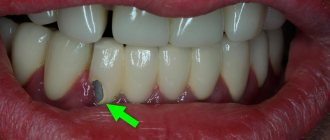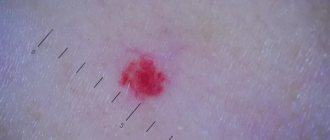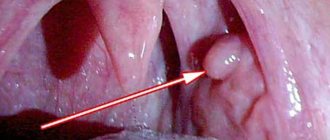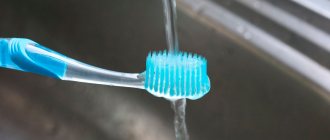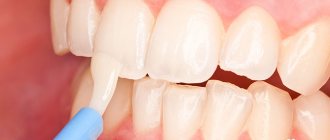General conditions
Existing or past diseases manifest themselves in the form of various inflammations and diseases of the oral cavity, teeth and gums.
- If in childhood you suffered from severe flu or measles, then in adulthood this can result in diseases of the periodontium (periodontitis, periodontal disease) and teeth (pulpitis).
- If your body suffers from a lack of water or it is difficult to remove it from the body, do not be surprised by bleeding and gum inflammation.
- Vitamin deficiencies, especially a lack of vitamin C, are the cause of loosening and even tooth loss.
- Diseases of the gastrointestinal tract manifest themselves in the form of a whitish coating on the tongue, cracks and inflammation of the tongue.
Human wisdom teeth
A “wisdom tooth” is the third outer molar with three to five roots. In structure it is no different from its “neighbors”. To the question “How many wisdom teeth does a person have?” cannot be answered unambiguously. They erupt around the age of twenty, one on each side of both jaws. However, there are people without wisdom teeth. This is a variant of the norm, since in the process of human evolution the need for the “eight” disappeared, and the structure of the jaws underwent corresponding changes. Today, third molars are considered a vestigial organ.
Each organ has its own tooth
It has been known since ancient times that the condition of a particular tooth can determine the disease in the corresponding group of organs. Today this is a scientifically proven fact. For example, by using the incisors above and below (teeth 1 and 2), diseases of the ears, bladder and kidneys can be diagnosed, and by the canines (3) the condition of the liver and gallbladder can be determined. Small molars (premolars 4 and 5) transmit data about the lungs and large intestine, and large molars (molars 6 and 7) about the stomach, spleen and pancreas, and the so-called “wisdom teeth” can tell about the condition of the heart and small intestine .
At the same time, affected teeth identified by a dentist during an examination do not always mean the presence of diseases in the corresponding internal organs. It happens that a patient presents with pain in apparently healthy teeth or even with phantom pain (a painful signal comes from an internal organ to the site of the extracted corresponding tooth). Knowing about these relationships, it is easier to identify the affected organs.
Reading your teeth about diseases
Not only tests, but also… teeth can tell about diseases of internal organs. An experienced dentist only needs to look into the patient’s mouth to understand the condition of the heart or gastrointestinal tract.
How does this method work and is it possible to predict illnesses simply by looking at teeth?
Many of us are familiar firsthand with the feeling of unbearable toothache, when it seems that the head, heart and stomach are immediately affected by one merciless incisor. There are many “lucky ones” who are not saved from the appearance of caries and other dental pathologies by either high-quality toothpaste, a medicated brush, rinsing, or even a timely visit to the dentist. Perhaps it is not the teeth that need to be treated, but other organs? For doctors practicing alternative treatment methods, there are no contradictions here - they know which tooth is responsible for which organ.
How does this method work and is it possible to predict illnesses simply by looking into your mouth?
Tit for an eye
Many of us are familiar firsthand with the feeling of unbearable toothache, when it seems that the head, heart and stomach are immediately affected by one merciless incisor. There are many “lucky ones” who are not saved from the appearance of caries and other dental pathologies by either high-quality toothpaste, a medicated brush, rinsing, or even a timely visit to the dentist. Perhaps it is not the teeth that need to be treated, but other organs? For doctors practicing alternative treatment methods, there are no contradictions here - they know which tooth is responsible for which organ.
Thus, problems with the gallbladder can result in the loss of one of the molars (the seventh back teeth), and constantly aching fangs will indicate cholecystitis or the threat of hepatitis. If there is a relationship between teeth and other organs, it is almost impossible to prove it, says academic medicine. “Any tooth, being problematic, can cause complications on other organs,” says periodontist surgeon Valery Kaminsky. “But we cannot talk about a direct relationship between each individual tooth and a specific organ.” Whom to believe – official medicine or the conclusions of the “populists” – decide for yourself, but it never hurts to know the position of both sides.
Keep your diagnosis close to your chest
Even minor damage to tooth structure can tell a lot. Of course, only a specialist and a detailed examination will give a complete picture of which tooth is connected to which organ and what problem it signals. But you can independently conduct a preliminary examination and compare the symptoms (see table). To do this, you need to consider the following:
1 The upper and lower incisors are used to judge the condition of the kidneys, bladder, ears and organs of the reproductive system. And their poor condition may indicate chronic pyelonephritis, cystitis, otitis media, tonsillitis, osteochondrosis and even prostatitis.
2 Fangs are responsible for the liver and gall bladder, signaling cholecystitis and hepatitis.
3 Small molars (premolars) are the lungs and large intestine. Problems with them can be caused by dysbiosis, colitis, allergies, chronic bronchitis or pneumonia.
4 The large molars (molars) are connected to the stomach, spleen and pancreas. Accordingly, the list of possible provoking diseases is as follows: gastritis, ulcers, pancreatitis, anemia, sinusitis, tonsillitis, endocrine system disorders, atherosclerosis, varicose veins and others.
5 Wisdom teeth “manage” the condition of the heart, blood vessels and small intestine. Therefore, a dentist can help in the treatment of coronary disease and even congenital heart disease. Pain in the joints also affects the condition of the front teeth of the upper and lower jaws.
“After thirty,” says dentist Igor Molozhanov, “many patients begin to have problems with their gums. If a person regularly takes care of his oral cavity, and bleeding gums do not go away, we can confidently say that the problem lies in other organs. In women, for example, one of the warning signs of mammary gland pathologies is the so-called causeless gingivitis (inflammation of the gums). In children, leukemia can manifest itself as gingivitis on the gums. The dentist treats periodontal disease session by session, while the child needs, at a minimum, a blood test.”
Sick - so together
If teeth often deteriorate due to diseases of the internal organs, then there is an inverse relationship: problems with teeth lead to various disorders and diseases.
It is known that toothache can cause terrible headaches. Moreover, sore canines and incisors of the upper jaw will come back to haunt the forehead and temples, and inflammation of the molars will give a dull pain to the back of the head.
Even the most common tooth decay can cause constant migraines. Periodontal (gum) problems contribute to the development of cardiovascular diseases, and pulpitis (inflammation of the dental nerve) provokes gastritis, colitis and cholecystitis.
Officially
From the point of view of official (academic) medicine, any inflamed tooth, which is a source of infection, the so-called chroniosepsis, poses a danger to the entire body. “Problem teeth (with caries, destroyed or dilapidated) entail a general decrease in immunity or outbreaks of infection in other organs,” explains dentist Elena Legeza. But the connection between teeth and diseases is not always proven. We can say with confidence that when a tooth becomes inflamed, products enter the gastrointestinal tract along with toxins. This causes a variety of diseases (depending on the state of a person’s immunity) ranging from ordinary indigestion to gastritis. But not a single dentist will undertake to draw a parallel between incisors and osteochondrosis.
“Painful symptoms affect the entire body,” says Valery Kaminsky, candidate of medical sciences. – When a person has a toothache, his head begins to hurt, his stomach or intestines, liver, bile ducts and even the heart suffer. The fact is that the dental nerve sends a signal to parts of the brain of the central nervous system and is connected with the nuclei of neighboring nerve cells, which respond to pain and transmit the signal to other organs. Moreover, the ways of transmitting pain are individual for each person. But the risk group primarily includes problematic, that is, unhealthy organs.” Therefore, if you have chronic bronchitis, do not be surprised that, having neglected your teeth, you suddenly developed pneumonia.
A comment
Igor Molozhanov, Head of the Department of Therapeutic Dentistry, Kyiv Institute of Traditional Medicine
According to statistics, about 95% of people suffer from caries. Based on which tooth is affected, at what age and to what extent, a specialist can diagnose the development of a serious disease in a patient. For example, diabetes mellitus in its early stages can also manifest as gum disease. The dentist may be the first doctor who, based on a sharp deterioration in the condition of the gums, diagnosed a person with diabetes.
A classic example of the connection between teeth and internal organs is the so-called liver tooth, when teeth are destroyed due to pathologies of the stomach or liver (the same gastritis, pancreatitis, etc.). But dentists are aware of other relationships.
There are three periods in the life of teeth.
Therefore, the correct diagnosis depends on the age of the patient.
For disorders of the gastrointestinal tract and liver:
in children 8–10 years old, the sixth and frontal teeth (first, second, third) are primarily affected; in adults, the sixth and seventh teeth are destroyed first.
For pathology of the respiratory system:
in children with pathology of adenoids, tonsils and polyps, the first and second teeth of the upper and lower jaws, and less often the canines, suffer. In adults, bronchitis, pneumonia and even asthma affect the first and second teeth of both jaws.
Diseases of the urinary system:
in adolescence and up to 25 years, the fourth and fifth teeth of the lower jaw are responsible for them. In adults, diseases of the fifth and sixth teeth of both jaws begin.
"Source".
Pain is a good signal
The connection between internal organs and teeth and the oral cavity is evidenced by medical statistics on patient treatment accumulated over many years. For example, bad teeth can be a source of headaches. Damage to molars - there is pain in the parieto-occipital region. A source of infection in the maxillary incisors can lead to pain in the frontotemporal region, and from diseased canines the pain can be concentrated in the temporal region. If you have problems with the teeth of the lower jaw, a migraine may develop, and it can only be alleviated by visiting a dentist.
Painful sensations in the upper and lower incisors are a reason to get checked for cystitis, otitis media, or treat chronic pyelonephritis. Pain in the first incisor is a possible syndrome of prostate adenoma, frontal sinusitis, tonsillitis, prostatitis, osteochondrosis. Aching pain in the fangs is possible with hepatitis or cholecystitis.
Chronic pneumonia can be diagnosed by pain in the 4th and 5th molars. The same focus of pain indicates colitis, advanced dysbacteriosis, an allergic reaction (rhinosinusitis, bronchial asthma, respiratory allergosis).
Dimensions of human teeth
The upper central incisors are twice as wide as their antagonists. The remaining dental units of the same name have approximately equal parameters. The size is determined using special tables with the optimal size and permissible deviations. Experienced doctors calculate proportions by dividing the length of a person’s teeth by the width. A result of about 0.75 millimeters is considered close to ideal. For more detailed diagnostics, other professional formulas and techniques are used.
Size deviations from the norm occur due to improper formation of the jaw, fusion of tooth buds, or genetic predisposition. Teeth that are too large are called macrodentia, and abnormally small teeth are called microdentia. Pathologies are accompanied by problems with bite and chewing functions, but can be successfully corrected by a dentist.
Interesting fact!
The longest tooth in the world belongs to an Indian teenager. The size of its crown is almost four centimeters. About a year ago, the tooth was removed, and the young man was included in the Guinness Book of Records.
A dental problem is not just a dental problem
Pain in the quads above and below can be a sign of weak ligaments (shoulder, elbow, wrist, ankle and knee joints), chronic inflammation of the joints (for example, polyarthritis), diseases of the large intestine - diverticulosis, polyposis.
Sixes and sevens (molars) are beacons of gastrointestinal diseases (gastritis, gastric or duodenal ulcers), advanced anemia, chronic pancreatitis. Problems with the top six are a reason to get checked for tonsillitis and sinusitis, diseases of the pharynx and larynx, tumor formations in the thyroid gland, mastopathy, and inflammation of the appendages. If something is wrong with the lower sixes, there are problems with the arteries, atherosclerosis. But the lower sevens are problems with the lungs (chronic pneumonia, bronchitis, bronchial asthma), polyps in the large intestine, something is wrong with the veins (varicose veins, hemorrhoids).
Have your wisdom teeth been bothering you for a long time? Make an appointment not only with the dentist, but also with the cardiologist. Coronary heart disease, congenital heart disease and other cardiac diseases - in terms of wisdom teeth. Plaque and tartar can be a signal of endocrine system disorders, a sign of gastric ulcer.
The structure of the human tooth
Anatomy
From an anatomical point of view, a human tooth consists of three parts.
- Crown.
The visible part protruding above the gum. It has four sides: the occlusal, or cutting edge, in contact with the antagonist teeth; contact wall adjacent to adjacent dental units; vestibular and lingual surfaces facing the lips and tongue, respectively. - Root.
Fixed in the socket by connective tissue, located in the recess of the jaw. As a rule, premolars have two roots, and molars have three, four or even five. The remaining dental units have one root canal. - Neck.
It is located between the coronal part and the root of a human tooth, surrounded by periodontium.
Histology
What are human teeth made of? Let's look at the cross-section of the structure of a human tooth.
- Enamel.
A transparent protective coating of the crown, almost entirely consisting of inorganic microelements. - Dentine.
The hard base of the tooth, containing 80% mineral components and 20% organic substances. The shade of dentin is responsible for the color of dental units, as it shines through the enamel. - Cement.
The bone tissue covering the tooth root. Plays the role of a fastening element connecting the tooth to the alveolus. - Pulp.
Soft tissue filled with bundles of nerves and capillaries. Painful sensations during caries are explained precisely by the presence of nerve endings.
On a note
You should not go to extremes and see any toothache as a serious disease of the internal organs. It could be ordinary caries and nothing more. After all, the cause of caries can be many different or a combination of several factors: past infectious diseases, stress, lack of microelements, metabolic disorders.
The listed symptoms only indicate that different systems of the body are interconnected. Moreover, this connection can also be the opposite: an infection from a diseased tooth can easily be transferred into the body with food and saliva. Damages often affect the cardiovascular system (increased blood pressure), the excretory system (the appearance of trophic skin disorders, increased sweating), and in some cases the nervous system.
During inflammatory processes in the teeth (caries, pulpitis), pain appears so acute that the person immediately grabs the pills and the pain goes away. It turns out that the signal from the diseased organ was never noticed. And the process of destruction does not slow down, foci of chronic infection arise, which can be a source of more serious disorders in the body (sometimes this can even result in a heart attack, meningitis, sinusitis). In order for the body to work smoothly, you need to contact the dentist in a timely manner. And at the same time, we should not forget that after treating a diseased tooth, it is advisable to examine the organs associated with it.
The influence of bite on posture
According to the observations of one of the most famous Russian-speaking orthodontists, F. Ya. Khoroshilkina, patients with malocclusion always develop musculoskeletal disorders: retraction and flattening of the chest, changes in the angle of the ribs, curvature of the legs and flat feet.
What is the mechanism of such profound changes at the bone level?
Correctly balanced head position - without bending forward or backward - eliminates stretching of the posterior ligaments of the neck and unnecessary tension in the neck muscles.
And with such a common pathology as distal occlusion the head is often located slightly anteriorly, which shifts the center of gravity forward from the vertical axis of the spine, which means the load on the neck muscles increases significantly. The same thing happens when the head is tilted back, which accompanies the so-called mesial bite.
Muscle spasms and pain appear, the ligamentous apparatus adapts to the muscles and entails deformation of the bones of the entire skeleton.
The influence of bite on posture
Teeth and energy channels of the human body
Eastern acupuncturists are confident that each tooth corresponds to an internal organ or an entire system.
Vital energy circulates throughout the body and interacts with different parts of the body, so pain in the teeth can be a manifestation of pathology in any human organ. For example, condition 4 root affects the chest muscles or lung tissue. Dentists know the facts when a patient complains of pain in teeth that have long been removed. Such phantom pains only confirm the close relationship of the oral cavity with organs along a certain meridian, because something that no longer exists cannot cause painful sensations. However, the bodies with which there was a connection can declare their problems in this way. Most doctors believe that the health of the entire oral cavity seriously affects the well-being of the entire body.



